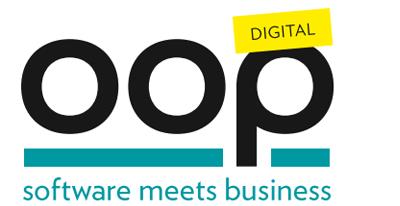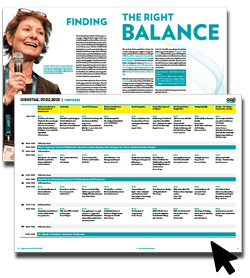Das gesamte Konferenzprogramm auf einem Blick? Kein Problem, alle Programminhalte finden Sie hier jetzt auch als praktische PDF-Broschüre ganz bequem zum durchscrollen, downloaden oder ausdrucken:
Zur PDF-Broschüre
Thema: Programming Languages
- Montag
06.02. - Mittwoch
08.02. - Donnerstag
09.02.
This highly interactive workshop is all about software architecture - with Spring Boot, the Java microservice framework. Using an example application, we will discuss and try out the following topics in code:
- REST API design
- Hexagonal architecture
- Bean validation
- Single sign-on with Keycloak
- Role-based security
- Optimistic locking with ETags
- OWASP dependency check
- Structured JSON Logging
- Error handling
- Integration tests with Cucumber
- Architecture tests with ArchUnit
- Local deployment…
The cloud has fundamentally changed how we design applications and introduced whole new categories of software-development disasters. With a focus on Java, this talk will introduce some of the new tools, patterns, and best practices for modern distributed application development. It also gives a tour of some of the most painful anti-patterns Holly has seen as a cloud consultant.
Target Audience: Architects, Developers, Strategic Decision Makers
Prerequisites: Basic experience of cloud computing,…
In der Vorweihnachtszeit 2021 wurden viele IT-Abteilungen von Zero-Day-Sicherheitslücken im weitverbreiteten Java-Logging-Framework Apache Log4j kalt erwischt. Diese Session fasst das Ereignis zusammen und sucht Parallelen zu ähnlichen Zero-Days. Hinweise zu proaktiven Maßnahmen helfen, zukünftig in ähnlichen Situationen schneller reagieren zu können. In diesem Zusammenhang wird u.a. auf Configuration Management und Infrastructure as Code nebst Automation eingegangen, aber auch auf Tools wie…
You've heard about this new feature in C++20, Coroutines, but it's the first time you have encountered this term? Then this talk is what you're looking for. We start from the beginning with just "normal" functions. Next, we introduce Coroutines. Using them, we explore the various customization points C++ offers. Another distinction we make is cooperative and preemptive multitasking, opening the door for another beauty of Coroutines, why we don't need locks.
By the end of this talk, you've…
As developers, our job is to deliver working software. With the shift to CI/CD and the move to the cloud, the need to have the right feedback at the right time only increases. There are many ways that testing can help us with that. Not only can testing help us verify our solution and prevent us from breaking things, it can also help us design our software, find flaws in our architecture and come up with better solutions. In this talk I will highlight some of the many ways that testing can help…
In this session I’ll examine some of the things that can go wrong when organisations jump headfirst into micro-service architectures without understanding the potential pitfalls.
I'll explain contract testing from the ground up. You'll learn how it can decouple micro-service dependencies during development, allowing your teams to work effectively. And I'll describe sophisticated, free, open-source tooling that helps integrate contract testing into your software lifecycle, giving you the…
Auch nach mehr als 20 Jahren ist Jakarta EE (ehemals Java EE) DER Standard, wenn es um die Entwicklung Java-basierte Enterprise Computing-Lösungen geht. Dies gilt zumindest immer dann, wenn die Anwendung als Monolith in einem Application Server deployed werden soll. Wie aber steht es mit einer Anwendung, die aus einer Vielzahl autark laufender Microservices besteht? Und wie gut schlägt sich Jakarta EE in der Cloud, in der geringer Speicherbedarf und schnelle Startzeiten gefragt sind?
Zielpubliku…
Webanwendungen ohne automatisiert getestete APIs machen im Betrieb und Weiterentwicklung schlechte Laune, egal, ob es um APIs zwischen Frontend und Backend, zwischen Microservices oder zu Drittparteien geht. Typischerweise beschreiben wir das erwünschte Verhalten der Anwendung, in dem wir uns selbst Beispiele als Testfälle ausdenken. Da geht mehr. In diesem Beitrag werfen wir einen Blick auf über "naive Integrationstests" hinausgehende Ansätze, von Contract Based bis hin zu KI-Unterstützung.
Zie…
Software containerisiert auszuliefern, ist mittlerweile sehr etabliert. Selbst bei Beachtung gängiger Best Practices ist es jedoch schwierig, Docker-Images reproduzierbar und sicher zu machen. Mögliche Folgen sind beispielsweise Versionskonflikte oder plötzlich fehlschlagende CI-Pipelines.
Mit dem Package-Manager Nix kann man einen großen Teil dieser Probleme vermeiden. Insbesondere das Nix-Tooling rund um Docker ermöglicht eine schmerzfreie Erstellung vollständig reproduzierbarer und minimaler…
Immer mehr Entwickler:innen schreiben Anwendungen, die später in einem Kubernetes Cluster laufen sollen. Was kann dabei so schwierig sein? Angefangen "Wie strukturiere ich meine Repositories?", "Wo lege ich meinen Code für das Deployment ab (Containerfiles, Helm Charts, Config Values)?", "Was muss bei der Entwicklung der Anwendung beachtet werden?", "Wie bekomme ich den Code lokal getestet?", "Wie bekomme ich mit, was im Test-Cluster passiert?"
Zielpublikum: Entwickler:innen, Architekt:innen
Vor…
Java applications are widely used and often several years old. You can use these applications in the cloud via lift-and-shift (helps nothing) or you can rewrite the application in cloud-native style and use the advantages of the cloud.
An alternative for existing applications is missing here. It must be possible to go to the cloud and use advantages such as serverless and scale-to-zero WITHOUT having to rewrite the entire application.
I will show what is already working well today and where the…
Micro Frontends sind in aller Munde. Und dennoch: Die Integration mehrerer Single-Page Applications zu einem großen Ganzen ist nach wie vor eine Herausforderung!
Wir vergleichen die verfügbaren Optionen samt deren Konsequenzen. Danach werfen wir einen Blick auf die nächste Generation von SPA-Frameworks, die hierbei viele der heutigen Nachteile gekonnt kompensieren.
Am Ende kennen Sie die Optionen für die Integration von Micro Frontends und können sie für Ihre Projekte bewerten.
Zielpublikum:…


